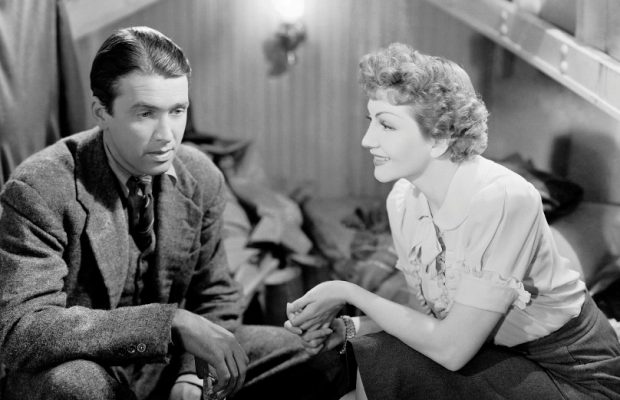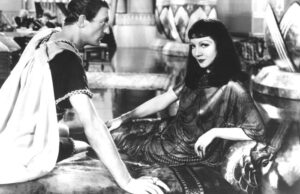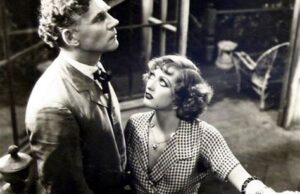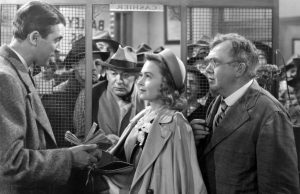It’s a Wonderful World (1939)

Toronto Film Society presented It’s a Wonderful World (1939) on Monday, March 20, 2017 in a double bill with Larceny, Inc. as part of the Season 69 Monday Evening Film Buff Series, Programme 7.
Production Company: MGM. Producer: Frank Davis. Director: W.S. Van Dyke II. Screenplay: Ben Hecht, based on his and Herman J. Mankiewicz’s original story. Cinematography: Oliver T. Marsh. Art Direction: Cedric Gibbons. Film Editor: Harold F. Kress. Music: Edward Ward. Set Decoration: Edwin B. Willis. Costume Design: Adrian. Release Date: May 19, 1939.
Cast: James Stewart (Guy Johnson), Claudette Colbert (Edwina Corday), Guy Kibbee (Fred “Cap” Streeter), Nat Pendleton (Sergeant Fred Koretz), Frances Drake (Vivian Tarbel), Edgar Kennedy (Lieutenant Miller), Ernest Truex (Willie Heyward), Richard Carle (Major I.E. Willoughby), Andy Clyde (“Gimpy” Wilson), Cecilia Callejo (Dolores Gonzales), Sidney Blackmer (Al Mallon).
Here is what James Harvey wrote in his book Romantic Comedy in Hollywood: From Lubitsch to Sturges:
It’s a Wonderful World is an example of how almost casually terrific the screwball mode could be. It’s a modest film in every way, and one of the fastest Colbert ever made. Director Van Dyke, nicknamed One-Take-Woody, outdid himself in the speed he shot the film, in a record twelve days, six fewer than he took on The Thin Man. But just as with The Thin Man, the speed shows up on the screen in mostly good ways—in crackle and verve and spontaneity. In some respects It’s a Wonderful World is an even more accomplished film—the comedy counterpart to the supremely assured and high-spirited work Van Dyke had done on the 1936 San Francisco. Ben Hecht wrote the screenplay; it’s in his Front Page vein with admixtures of two screenplays he didn’t write, It Happened One Night and Bringing Up Baby, as well as a surprising foreshadowing of the forties private-eye film.
Like Cary Grant in Bringing Up Baby, Stewart is a man on a quest, and saddled with a companion whose blitheness and inconsequence fill him with mounting and helpless fury…. But unlike Hepburn’s character, the Colbert heroine is neither rich nor dizzy. And though she, too, has great self-assurance, it’s more like a suburban matron’s than a blueblood’s. From her first appearance (which does include handcuffs, by the way)—peering out from behind a tree with wide, startled eyes, in a mannish suit and absurd little flowered pillbox hat—she evokes the clubwoman world of Helen Hokinson’s New Yorker cartoons. We even learn that she is on her way to lecture to a woman’s group.
Introduction by Caren Feldman
Plot: Private detective Guy Johnson (Stewart) is well paid to look after rich Willie Heywood, whose love of drink tends to get him into trouble. When Heywood visits his ex-girlfriend Dolores Gonzalez, he is framed for her murder and Guy has to find the real culprit, hiding his client while he searches for the killer. But both are arrested by the police and put on trial. Heywood is sentenced to death and Guy to a year’s imprisonment. On his way to prison, Guy manages to escape and is befriended by the poet Edwina Corday (Colbert) who, after some initial antagonism on both sides, agrees to help him in his search.
Reception: Though it has been somewhat overshadowed by its near-namesake (Frank Capra’s 1946 film It’s a Wonderful Life), assessments today are highly favourable. Leonard Maltin finds it “very, very funny, with Stewart having a field day”, while other commentators praise the chemistry between the stars, and call it “a little-known treasure” and “hysterically funny”.
W.S. Van Dyke (1889-1943): A prolific and reliable director whose lengthy career spanned both the silent and sound eras, and who was known as “One Take Woody” for his quick and efficient style of directing. He accompanied his mother on the vaudeville circuit, as a child actor, and then went through several jobs before arriving in Hollywood in 1915. He was an assistant director to D.W. Griffith on Birth of a Nation and Intolerance, and directed his own first film in 1917, along with four other titles. He then made a large range of both silent and sound films for MGM as one of their most versatile and best-liked directors, including White Shadows in the South Seas (1928); Manhattan Melodrama (1934); The Thin Man (1934) and three of its sequels; as well as six of Jeanette MacDonald and Nelson Eddy’s greatest hits and his own hugely successful San Francisco (1936). He served in the Marine Corps during World War II and encouraged stars like James Stewart, Clark Gable, and Robert Taylor to join the war effort, but fell ill with cancer in the early 1940s and, after having refused medical care as a devout Christian Scientist, committed suicide in 1943.
James Stewart (1908-1997): Affectionately known as “Jimmy” to filmgoers and co-workers alike, Stewart was one of the best-loved and most talented of male film stars, his only real competitors being Humphrey Bogart, Clark Gable, and Cary Grant. He became a representative of basic human decency and dignity in almost all his films, though his work with Alfred Hitchcock and Anthony Mann in the 1950s revealed unexpected depths of psychological complexity beneath the affable “everyman” surface of his earlier work.
He was born in Pennsylvania of mainly Scottish ancestry and showed early interest in aviation, spending much time in his childhood building model aeroplanes in hopes of finding a career as a pilot. Stewart then developed an interest in drama and music, as a student at Princeton, performing in the University Players in the summer and becoming friendly with the then-married Henry Fonda and Margaret Sullavan, as a result. He made his Broadway début in 1932 at a time when the Depression was seriously affecting theatre audiences. He struggled there for two years, until his work attracted the interest of an MGM scout, and he took a screen test before joining Fonda in Hollywood as a contract player, in 1935. After initially mixed success, he received better roles and some acclaim for After the Thin Man and Wife vs. Secretary (both 1936).
In 1938, after a brief affair with Norma Shearer, he was loaned out to Columbia, where his minor role in Navy Blue and Gold attracted the attention of Frank Capra, who cast him in You Can’t Take it with You along with Jean Arthur. This began his hugely successful collaboration with both actress and director that continued in Mr. Smith Goes to Washington, in which Stewart won the first of five Academy Award nominations as Best Actor, with Capra later calling him “probably the best actor who’s ever hit the screen”. Stewart then made his first Western, the parody Destry Rides Again, with Marlene Dietrich, in 1939. In 1940, he starred with Margaret Sullavan in both Ernst Lubitsch’s The Shop Around the Corner and Frank Borzage’s The Mortal Storm, as well as his Academy Award-winning role (his only one) in The Philadelphia Story. After a few screwball comedies in 1940 and 1941, Stewart was drafted into the US army, where he was accepted only after gaining he necessary weight required for new recruits. His childhood interest in aviation had led to his obtaining commercial certificates as a pilot in the 1930s. After enlistment in the Army, he applied for a commission in the Air Corps and, despite being beyond the maximum required age, was accepted and engaged; first in recruitment programs, before being promoted to first lieutenant in 1942, and then to squadron commander, in 1943. Anxious for combat duty rather than selling war bonds, Stewart managed to get himself assigned to the 445th Bomb Group. He quickly became its commander and flew on his first combat mission in Europe in 1943, leading raids on German targets, before being promoted to major and being awarded the Distinguished Flying Cross and receiving further promotion to lieutenant colonel. He continued to fly uncredited on combat missions, despite having fulfilled the necessary quota of missions required, and was promoted to full colonel in 1945. By then, he had become one of the few Americans to rise from private to colonel in only four years. He remained active in the Air Force Reserve after the War, being promoted to brigadier general, and finally retiring in 1968.
Stewart returned to Hollywood in 1945, with his first film being Capra’s It’s a Wonderful Life, in 1946, in which he displayed a new, almost ferocious screen personality, especially in the scenes of his apparent failure as a businessman and father. Some critics have attributed the change to his war experiences and what would now be called “post-traumatic stress” and, though the film was nominated for five Academy Awards, including one for Stewart as Best Actor, it was a relative failure at the box office until, in recent years, being reassessed as one of the finest ever American movies and becoming a Christmas classic. It was followed by another financial flop, Magic Town, directed by William Wellman, though he had better luck with Hitchcock’s Rope and the Italian neo-Realist influenced Call Northside 777, and then huge success on both stage and film for Harvey, which ran for nearly three years on Broadway. Stewart then returned to film and the western for Broken Arrow (1950) and his first collaboration with Anthony Mann, Winchester ’73 (also 1950), which began an impressive eight-year partnership, including Bend of the River, The Naked Spur, and The Man From Laramie, in which Stewart usually plays a troubled, bitter, and disillusioned cowboy seeking redemption in a corrupt society, who often has to resort to violence in self-defense–films which played a major role in removing some of the romance of the genre and making it more disturbingly realistic. Other films made with Mann included The Glenn Miller Story and Strategic Air Command, which made use of Stewart’s wartime experiences.
An equally important collaboration and change of screen personality came with the films Stewart made with Alfred Hitchcock in the 1950s, in which he is again a troubled figure confronting his repressed fear and desires and projecting them on others. First, in Rear Window (1954), which established Stewart as the most popular star in the world; then, The Man Who Knew Too Much; and finally, Vertigo (1958), initially scorned by critics but now enshrined by Sight and Sound–perhaps debatably–as the greatest film ever made, though it is certainly a masterpiece. Others of Stewart’s later films include Anatomy of a Murder (1959); three films with John Ford, including Two Rode Together and the critically acclaimed The Man Who Shot Liberty Valance; Shenandoah, with a Civil War theme; some other family-oriented films, few of them memorable; and the more successful The Flight of the Phoenix and The Shootist, in the latter of which he had a supporting role to John Wayne. He also appeared frequently on television in the late 1960s and early 1970s, but was more often involved in social and political activities, including strong opposition to attempts to colourize black and white films, such as It’s a Wonderful Life. He delayed marriage until the age of 41, when he adopted his wife’s two sons, one of whom was killed in action in Vietnam in 1969. When asked how he wanted to be remembered, he said, “As someone who believed in hard work and love of country, love of family, and love of community.”
Claudette Colbert (1903-1996): Born Émilie Claudette Chauchoin in France to French parents, she was seven when her family immigrated to New York. She was already fluent in English, thanks to her grandmother, and remained fluent in French throughout her life. At school, she was more interested in fashion design and commercial art than in acting, but was encouraged by friends to take small theatrical roles, at which point she changed her name to Claudette Colbert. She achieved some success on Broadway in The Barker, in 1927, after which she was given the main role in a now-lost Frank Capra silent film For the Love of Mike. She then signed a contract with Paramount which, like other studios, was searching theatres for actors comfortable with sound. Colbert had box office success with her first film, The Lady Lies, in 1929. She then appeared with Maurice Chevalier in The Big Pond (1930) and The Smiling Lieutenant (1931), and with Fredric March in Manslaughter (1930), along with several other films. Her big chance came when Cecil B. DeMille cast her as the Emperor Nero’s wife Poppaea in The Sign of the Cross, in 1932, with a risqué nude bathing scene which caused a sensation and helped her to become a major box office star. After several more commercial successes, and having re-negotiated her contract with Paramount, she was offered the role of the runaway heiress in Columbia’s It Happened One Night, which had already been turned down by Constance Bennett, Miriam Hopkins, and Myrna Loy. The leading male role was forced on Clark Gable by MGM as punishment for contract disagreements. The film, directed by Frank Capra, was a massive success, winning several Oscars, including one for Colbert as Best Actress. This was followed by another De Mille extravaganza, Cleopatra, in 1934, and then by the racially-themed tearjerker Imitation of Life (remade by Douglas Sirk in 1959). By 1935, Colbert was named as one of the top money-making stars in Hollywood. Continued success came with The Gilded Lily, in 1935, where she co-starred with Fred MacMurray in the first of seven collaborations. Her marriage with director Norman Foster ended while she was making She Married Her Boss, in 1935, after which she remarried–a doctor, Joel Pressman, who remained her husband until his death in 1968. The Foreign Legion epic Under Two Flags (1936) saw her as a camp follower, “Cigarette”, and then came two films with Charles Boyer and the disappointing Bluebeard’s Eighth Wife, directed by Ernst Lubitsch with a script by Billy Wilder and Charles Brackett. Midnight, however, also scripted by Wilder and Brackett, and directed by Mitchell Leisen, was one of her best films; she impressed her co-star Gary Cooper with her knowledge of lighting and cinematographic techniques. This was followed by her first colour film, John Ford’s Drums Along the Mohawk (1939), though she was unhappy with Technicolor and preferred black and white from then on. The Spanish Civil War film Arise, My Love (1940) was later cited by her as her own favourite film, and was followed by another of her best works, Preston Sturges’s The Palm Beach Story, in 1942. In the meantime, she had been appearing on CBS’s popular Lux Radio Theater and other radio programmes. The early 1940s saw major success with So Proudly We Hail! (1943) and Since You Went Away (1944), but these also saw the apex of her career, followed by a slow and steady decline which was interspersed with box office success in The Egg and I (1947), with Fred MacMurray, and critical success in Three Came Home (1950), about Americans imprisoned by the Japanese in Borneo during the Second World War. In the 1950s, Colbert returned to Broadway and, afterwards, appeared more frequently on the stage or on television, with her last film being Parrish, in 1961. Colbert was much liked and admired by fellow actors throughout her career, with many of them crediting her with valuable advice and tips that strengthened and enriched their performances, especially at the start of their own careers.
Notes by Graham Petrie













Leave a Reply